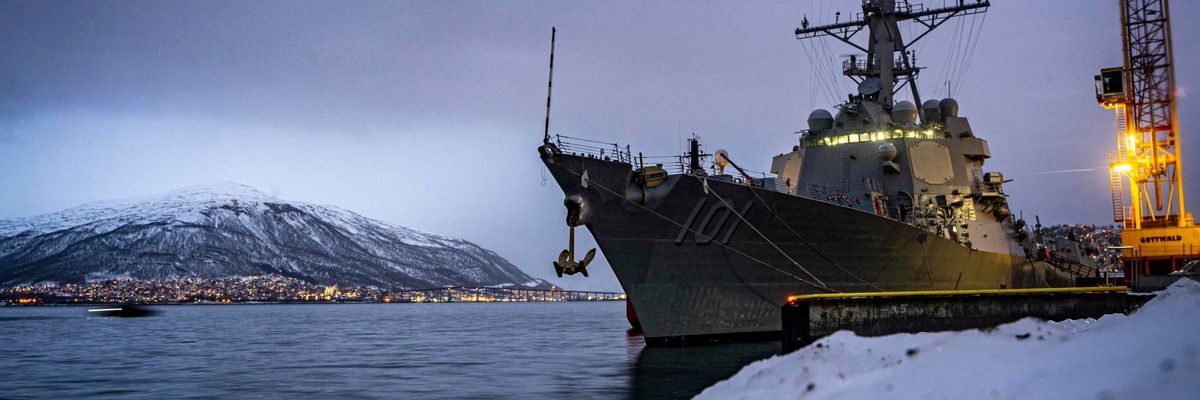The Biden administration’s recent announcement that it would review the oil and natural gas reserves off of the Alaskan coast is an urgent and underappreciated undertaking. Arctic sea ice is quickly receding, opening the region to great power competition and resource extraction.
The U.S. military has certainly taken notice as it has quietly dispatched flotillas of destroyers to the area, and the Air Force has decreed that by 2022, more advanced fighter aircraft will be based in Alaska than any other place on the planet. Such actions are lauded by many theorists, who argue that the United States must fortify its northernmost reaches, given the growing value of the American Arctic and the enhanced military presence of Russia and China. Nevertheless, Washington must avoid such substantial militaristic measures, since they are unnecessary and misallocate significant funds and resources that could be better used elsewhere.
The United States has far fewer motives to militarize the Arctic than any other Arctic state. Despite its enormous size and resource-rich reputation, Alaska is only the country’s 6th largest oil-producing state, with the nation’s 11th-largest proven natural gas deposits and 1 percent of America’s coal. And although there are massive untapped hydrocarbon deposits off the state’s coast, the utility of extracting these resources is questionable given the United States is already a net exporter of energy, most of these deposits lie in protected areas, and natural resource rents (of all types) compose a paltry 0.6 percent of the country’s GDP.
Resource protection is not the only argument analysts make for deploying the military northwards. Many view the Northwest Passage that borders Alaska as a trade route of increasing importance that warrants substantially increased fortification. However, there is limited utility in deploying military units on its behalf. The route is handicapped by stubborn sea ice deposits, the inconvenient paths that shipping must use, and a critical shortage of supporting infrastructure; not to mention that Canada claims most of the route as its sovereign territory (and holds more influence over it, regardless of the validity of its assertion). Even if these pitfalls are addressed, it is unclear how a bolstered military presence could help facilitate northerly trade.
America’s territorial disputes also don’t warrant military action: the sovereignty dispute over the Northwest Passage with Canada is far from hostile. There are growing incentives for both parties to resolve the dispute and some proposed solutions present opportunities for mutual gain and cooperation. Similarly, the territorial dispute in the Beaufort Sea concerns an area smaller than New Hampshire with dubious economic potential, and both nations’ proposed settlements grant each other sizable territorial gains. Additionally, military deployments would do little to help resolve territorial disputes, given Canada is a close American ally.
There is also the question of U.S. national security priorities. Why should Washington spend exorbitant sums fortifying the Arctic with specialized, expensive equipment when it has more pressing concerns in other regions? Arctic bases are expensive and painstaking to build and operate, a problem that climate change will exacerbate. The next generation of icebreakers cost between $700 million and $1 billion each, and they aren’t exactly designed to conduct freedom of navigation exercises in the South China Sea. This isn’t to say that the country should avoid building any icebreakers, but policymakers must budget defense spending with a clear understanding of its national security priorities in mind.
Still, perhaps the most prevalent justification to bolster the U.S. military presence in the Arctic is to counter Russia’s military buildup there. However, Russia’s militarization of the region has little to do with the United States and its national security ambitions; there is simply more at stake for Russia’s own economy. Russia’s Arctic coastline is 15 times longer than the U.S. equivalent. Its Arctic territory contains 48 billion barrels of oil and 43 trillion square meters of natural gas, resources which the Russian government and economy are highly dependent on (resource rents comprise more than 13 percent of its GDP). Additionally, Russia has deployed military and government units to bolster its claim to the Lomonosov Ridge region, a valuable and sizable area in the central Arctic; and recognizes the growing viability of the Northern Sea Route, which is now navigable by merchant ships as early as February.
The passage, which connects East Asia with Europe over the Russian coast, promises to expedite intercontinental trade, and Moscow seeks to enforce full sovereign control over this route. Russia has a plethora of compelling reasons to fortify the Arctic, least of which is to threaten America’s national security. So why should scores of F-22s and F-35s stand by in Alaska, awaiting an invasion that will never come?
The other three Arctic nations also have far more influential incentives for Arctic military deployments than the United States. Canada claims most of the Northwest Passage and is deeply invested in northern economic development; Denmark (through Greenland) possesses a quarter of Earth’s proven rare earth element deposits; and Norway has its own contentious disputes with Russia, as well as vital resource reserves. Moreover, Canada and Denmark are also involved in the Lomonosov dispute. China’s ability to operate in the Arctic is also limited, considering the nonexistence of Chinese Arctic bases (a problem it’s unlikely to solve) and the serious constraints on its regional alliance with Russia.
The Arctic has remained a remarkable haven of cooperation and stability. Simply because it is becoming easier to increase military buildup in the region does not mean it is necessary or beneficial for the United States to do so. To be sure, there are areas in which Washington needs to increase its Arctic investments, such as its badly neglected icebreaker fleet, infrastructure, and search and rescue on Alaska’s northern coast, and increased Coast Guard patrols of its exclusive economic zone as the melting ice opens it to exploitation.
But influential foreign policy leaders such as former Secretary of the Air Force Heather Wilson and Air Force Chief of Staff David Goldfein, who lauded America’s decision to make Alaska the global capital of 5th generation fighter aircraft, overstate America’s needs and commitments in the Arctic. These aircraft, just like the destroyer flotillas, will languish mostly unused in Alaska, costing countless taxpayer dollars and providing little in return. Wilson and Goldfein’s remarks allude to a fundamental issue in American foreign policy: just because we can become a dominant regional force doesn’t always mean it’s in our best interests to do so.
















